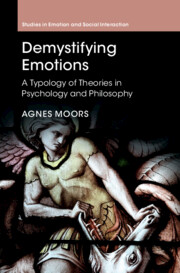Book contents
- Demystifying Emotions
- Studies in Emotion and Social Interaction
- Demystifying Emotions
- Copyright page
- Contents
- Figures
- Tables
- Boxes
- Preface
- Acknowledgment
- Abbreviations
- Part I Introduction
- Part II Emotion Theories One by One
- Chapter 3 General Precursors
- Chapter 4 Evolutionary Theories
- Chapter 5 Network Theories
- Chapter 6 Stimulus Evaluation Theories
- Chapter 7 Response Evaluation Theories
- Chapter 8 Psychological Constructionist Theories
- Chapter 9 Social Theories
- Part III Conclusion
- References
- Index
- Titles Published in the Second Series (continued from page ii)
Chapter 8 - Psychological Constructionist Theories
from Part II - Emotion Theories One by One
Published online by Cambridge University Press: 11 August 2022
- Demystifying Emotions
- Studies in Emotion and Social Interaction
- Demystifying Emotions
- Copyright page
- Contents
- Figures
- Tables
- Boxes
- Preface
- Acknowledgment
- Abbreviations
- Part I Introduction
- Part II Emotion Theories One by One
- Chapter 3 General Precursors
- Chapter 4 Evolutionary Theories
- Chapter 5 Network Theories
- Chapter 6 Stimulus Evaluation Theories
- Chapter 7 Response Evaluation Theories
- Chapter 8 Psychological Constructionist Theories
- Chapter 9 Social Theories
- Part III Conclusion
- References
- Index
- Titles Published in the Second Series (continued from page ii)
Summary
This chapter discusses psychological constructionist theories (PCTs). PCTs reject the existence of affect programs as special-purpose mechanisms for the phenomena called emotions. PCTs come in a two-factor version, endorsed by Schachter (1964) and Barrett (2017b), and a multi-factor version, endorsed by Russell (2009). Two-factor PCTs propose that emotions result from the combination of (a) diffuse bodily feelings and (b) a construction process that binds these felt bodily responses to external stimuli and produces a labeled feeling. The multi-factor PCT proposes that the phenomena that people call emotions are composed of many components. The categorization of these components does not result in an emotion per se, but an emotional self-ascription. Two-factor PCTs can deliver discrete emotions. The multi-factor theory does not deliver discrete emotions, but can nevertheless make sense of them. Empirical research that tests two-factor PCTs is discussed.
Keywords
- Type
- Chapter
- Information
- Demystifying EmotionsA Typology of Theories in Psychology and Philosophy, pp. 245 - 266Publisher: Cambridge University PressPrint publication year: 2022

